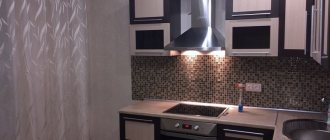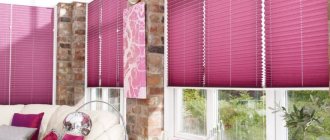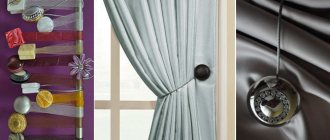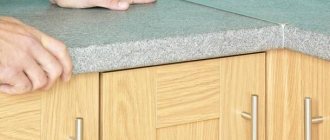The principle of operation of the mechanism
The mechanism can be:
- rope;
- ball;
- spring;
- automatic.
Rope mechanism
A simple and common option consisting of a rope and a roller. The length of the curtain is adjusted by shortening the threads located between the elements. The canvas rises, contracting into an accordion.
Ball mechanism
Assembly stages.
The shaft is driven by a special chain. This mechanism requires the presence of an additional element - a drum that transmits force to the pipe. It is located at the end of the curtain on the right or left side.
The chain looks like small balls strung on a thin thread. There is a small distance between them, the same along the entire length of the chain. There are grooves cut into the drum into which the chain balls fit. The shaft is set in motion by the impact of the balls on the drum, this is similar to the mechanism of a bicycle chain.
The weak point is the fragility of the structure. The material of manufacture is plastic, which quickly wears out and becomes unusable, but most chains can be replaced. To extend the service life of the product, you need to move the chain carefully, without jerking.
Spring mechanism
Due to the lack of assisted control systems, these curtains look attractive, which is why they are popular for decorating windows in offices or bedrooms. The device is equipped with a spring connected to a shaft. The spring can be located both at the top and at the bottom, so such curtains can be placed anywhere on the sash. This design is universal and will suit all types of windows.
Fixing the canvas is carried out in several ways:
- With a pen. The system has a connection with stops that hold the curtain. To fix the blade, you need to turn the handle.
- Stopper ball. The element is located on the roller and allows the canvas to move up and down. To fix the curtain, it must be moved sharply upward, this will lead to the ball blocking the passage and stopping the system.
- With hooks. A common option in which the curtain is fixed by adhesion to the hook. The fixing elements are located along the entire length of the window sash.
Over time, the spring stretches, which leads to breakage of the structure, so this version of the mechanism is considered short-lived and is not recommended for installation in rooms where there are small children.
Automatic mechanism
The curtain is equipped with an electric motor that acts on the transmission and sets the curtain in motion. System control can be:
- stationary - several buttons are installed on the window, pressing which sends a signal to the main mechanism;
- remote – the receiver and remote control are used as a regulator;
- automatic - a complex version of the mechanism, which includes not only an engine and a shaft, but also sensors that react to the level of lighting and, depending on it, start the motor.
Automatic roller blinds are convenient, but if they break, you cannot fix them yourself. To do this, you will have to contact a repair shop.
Possible installation errors
Problems that are often encountered:
- Incorrect location of brackets.
- Violation of the geometry of the structure: distortions and waves appear when the canvas moves.
- Damage to the plastic profile when installing curtains with screws.
- The roll structure has been assembled incorrectly, causing the fabric to move with difficulty.
Roller blinds can be glued or attached with self-tapping screws. Each method is selected under certain conditions. For example, self-tapping screws are used inside the opening, on the wall and ceiling. To fix the structure on the frame or sash, choose the mounting option using adhesive tape.
After installation is completed, it is allowed to attach plugs. It is possible to attach such curtains using clips. They are hung through the doors from above.
Types of structures
Practical material.
What does a roller blind consist of?
The design of roller blinds includes several parts:
- Shaft. The diameter of this element is directly proportional to the thickness and length of the curtain fabric. The shaft is made of aluminum or steel.
- Drive unit. The element that makes the curtain move. The structure is assembled so that the shaft can rotate in both directions. The drive is controlled both mechanically and automatically.
- Protective box An optional element that serves a decorative function to hide the shaft.
- Canvas.
Suitable materials
For the manufacture of roller blinds use:
- Polyester. The advantage of the material is its practicality and service life. It has good light absorption, light transmittance and light reflectance.
- Polyester and cotton. The combination of natural material and synthetics produces a fabric with universal properties. It has minimal shrinkage - about 1-1.5%, but this fabric is not recommended for use in rooms with high humidity, so that it does not deform during use.
- Combined fabrics: polyester with satin or viscose. Such materials are heterogeneous in texture and look like Japanese fabrics.
- Polyester with satin and acrylic coating. The fabric has an invisible protective layer, is pleasant to the touch, does not shrink and retains its decorative properties for a long time.
- Blackout fabrics. Thick curtains that do not allow daylight to pass through.
- Scorched canvases. The production of these fabrics involves partial destruction of the fibers by acids.
- "Screen." Dense fabric consisting of fiberglass and polyvinyl chloride in a ratio of 36 to 64. Durable fabric that does not stretch during use and does not shrink. It protects from sunlight, allows you to completely darken the room and is not afraid of contact with moisture.
Tips for choosing an ornament
Cosy.
When choosing colors and patterns, you need to focus on the interior design - what colors predominate in the room, in what style the room is designed. In the classic version, the color of the canvas should be close to the tone of the wallpaper. This will avoid the “square on the wall” effect. The sharp contrast of curtains and wallpaper will visually reduce the size of the room.
Color affects the psyche of people in the room, so it would be useful to take this factor into account, for example:
- White is a universal classic color that will fit into any design, especially if the room is located on the south side. Such a curtain will visually make the space freer and will not attract attention.
- Beige is identical to white, but less easily soiled.
- Yellow is a positive color that lifts your spirits. Suitable for children's rooms and rooms deprived of bright sun.
- It is better not to use orange in the bedroom, because... its invigorating effect will negatively affect falling asleep. Suitable for rooms where the interior contains calm colors.
- Pink sets a romantic mood and combines well with pastel shades.
- Blue sets the mood for relaxation and has a calming effect on the psyche. Suitable for children's rooms and bedrooms.
- Green is an inspiring color, suitable for a loggia, kitchen, living room, nursery and office.
- Brown is a universal noble color, suitable for any room.
Light shades visually make the room more spacious, while dark shades, on the contrary, cramp the space. This also needs to be taken into account when choosing colors.
In order not to overload the interior, you should follow simple rules:
- if the wall has plain wallpaper without a pattern, then the curtains can be selected with any pattern;
- For wallpaper with a bright pattern, it is better to choose a plain material;
- An original combination in the interior is represented by wallpaper and roller blinds made from the same material; identical curtains and tablecloth look no less interesting.
Photos of interiors made by designers can come to the rescue. In such works you can find inspiration, catch a harmonious combination of colors and apply them in practice.
Taking measurements for a window
Preparation and measurements.
Roller blinds can be installed:
- inside a window opening;
- outside the opening;
- for each transom.
Based on the installation option, measurements of width and height are made. The width of the roller blinds is identical to the width of the glass, taking into account the side beads (elements that hold the glass in the frame) plus 1 mm on each side. When measuring the window, you need to make sure that after installation the auxiliary mechanisms will not rest against slopes or hinges.
Height is measured from the top to the bottom sash. If the glazing beads are round, then the height should be measured so that the curtain overlaps the border of the frame by 2-5 mm. If the frame is blank, then 0.5 mm should be added to the measurements; in the case of an opening transom, 5-7 mm should be added to the length.
The width of the window can vary, so you need to measure it in several places.
How to make a mechanism with your own hands
A few simple steps to make a reliable mechanism for roller blinds. Where should you start?
Measurements
To attach the curtains to the wall, you will need to measure the window opening. To the width you need to add 6 cm for allowances, to the length about 20 cm plus the distance for allowances. You can also make the curtain yourself.
People who do not have experience in the production of roller blinds should refer to the method of mounting on the wall, and not on the frame.
Window opening measurement
Required material and tools
Before starting work you should prepare:
- The basis for attaching the material: a wooden plank or a special ready-made cassette system.
- Weighting material: metal or wooden strip.
- Stapler or hammer with small nails.
- Screwdriver.
- A couple of bearings.
- Autogen or welding machine.
Step-by-step instruction
Before creating the mechanism, you will need to attach a wooden block base to the wall. Next, the assembled or finished mechanism is installed on it.
To make your own, follow these steps:
- Prepare 2 bearings, a stainless steel pipe (you can take a wooden strip, but with a round cross-section).
- A slot is made along the length of the pipe to release the tissue using an autogenous machine.
- The rolled base—the fabric itself—is attached to a wooden beam with a stapler.
- Bearings are installed on the beam rod, ensuring a tight fit inside the pipe.
Follow the given guide and step by step you will achieve the desired result.
Preparing materials for use
Impregnation of fabric curtains
To ensure that the curtains are easy to clean during operation and do not quickly become dirty, you need to select a water-repellent material. You can make fabric with such properties yourself; there are several recipes for this.
Recipe No. 1
You will need:
- 0.5 kg of rosin (can be replaced with coniferous tree resin);
- 0.5 kg of grated laundry soap;
- 0.5 kg of acetone;
- 0.5 kg of laundry soda;
- 5 liters of water.
Cooking sequence:
- Heat water to a boil, add soap shavings and baking soda.
- Dissolve rosin in acetone, pour into water and mix thoroughly.
- Dip the fabric into the resulting solution and leave to soak for 12 hours.
Recipe No. 2
Fabric care.
You will need:
- 0.3 kg of copper sulfate;
- 12 liters of water.
Prepare a solution and soak the fabric in it for 5 days. After this time, the material will acquire water-repellent properties.
Recipe No. 3
You will need:
- 120 g of alum;
- 300 g quicklime;
- 12.5 liters of water.
Mix all ingredients thoroughly. Soak the fabric in the resulting solution for 12 hours.
If natural material is used, such as cotton, the curtain pattern must be made with a margin, because upon contact with water, the fabric will shrink and after soaking it will be smaller than its original size.
Step-by-step instructions for creating a product
Do it yourself.
Required Tools
You can assemble a roller blind using available materials; for this you will need:
- Textile. The curtain can consist of one sheet and cover the entire window, or of several parts and cover each sash. The amount of fabric depends on the size of the window. When purchasing material, you need to take into account that one such curtain consists of two identical parts.
- Tapes, ropes and cords. Used for garters. The length of the rope should be 2-3 times greater than the structure itself.
- Weight tube. It can be wooden or metal.
- Rod-shaft. Its length is determined by the width of the canvas, but may be slightly less. The shaft diameter is 2.5-5 cm. You can use a ready-made kit for roller blinds, which includes a special roller with a lifting mechanism. If necessary, the roller is shortened to the required size and attached to the window frame.
- Self-tapping screws, screwdriver or screwdriver, drill, dowels.
- Sewing supplies.
Stained glass models
Step-by-step master class on creating roller blinds:
- Lay the material out on a flat surface and measure the length; it should correspond to the height of the window plus 15-20 cm. The margin is needed so that when unfolded the fabric fits around the shaft.
- Using a square, mark the bottom edge of the curtain and draw a line, cut out a rectangle - this will be one side.
- Make a pattern for the reverse side in the same way.
- Fold the prepared fabrics right sides inward and stitch along the perimeter, leaving one short side unsewn. It should look like a bag.
- Turn the product inside out so that the right side of the material is on the outside, straighten the corners and carefully iron the edges of the fabric.
The next step is fixing the weight tube. The length of the latter should correspond to the width of the curtain. Sequencing:
- Place the tube against the unstitched edge, tuck the fabric in and mark the place for stitching.
- Sew a stitch on a sewing machine.
- Thread the weight tube.
Manufacturing of the fixation mechanism
Easy choice.
The fixation mechanism can be made using tapes, for example rep tape, 4-5 cm wide. The length of the tape is determined by the formula: 2X + 30 cm, where X is the height of the window.
Lay the curtain on a flat surface, wrap the upper part (opposite to the one where the weighting agent is inserted) around the rod and secure with small nails at 2 cm intervals or with a construction stapler. In the same way, attach the fixation strips to the rod so that they are longer than the curtains.
Assembly on the cornice
The rod-shaft together with the curtain must be secured in the window opening, using a level as an auxiliary tool. This will help install the structure parallel to the window sill.
When installing the rod, you need to make sure that the material wound around it will fit in the area between the shaft and the window. To avoid mistakes when installing curtain rods for roller blinds, you can watch the video; instructions from professionals will make it easy to complete all the work.
No drilling
To hang roller blinds on plastic windows without drilling, you need brackets or strong double-sided tape. Brackets can be purchased as separate components. They are installed directly on the top edge of the sash, the side plugs are put on, and then the roller is snapped into them.
Double-sided tape will be required for doors that do not open. If you do not want to drill the surface of the window, the elements of the shaft mechanism are glued directly to the tape. When using brackets, it is also advisable to additionally attach them with double-sided tape.
Advantages and disadvantages of roller blinds
Roller blinds are well suited for rooms with bright sunlight; they can be used to regulate the amount of daylight in the room. The advantage is the possibility of wet cleaning without removing them from the window. They are less easily soiled compared to classic curtains, because... impregnated with a water-repellent composition. This piece of furniture does not take up much space and does not burden space, so it is suitable for small rooms. Another advantage of roller blinds is the price, because they use much less fabric than classic ones.
The main disadvantage is the weakness of most mechanisms, which can quickly become unusable. They are difficult to install on windows with vents. In addition, such curtains are not compatible with some types of interior design, for example, Baroque, Gothic, Renaissance, etc.
Roller box
The roller can be hidden under a box (standard white or to match the canvas) - this is aesthetically pleasing, plus additional protection from dust and dirt. The weighting material, guides and roller box are together included in the cassette roller blind kit - an improved version of the roller blind. The cassette curtain looks neat and harmonious on the window.
For those who have never used roller blinds before, it is recommended to visit the appropriate department in Leroy Merlin to look at the roller blinds in person. The store presents the most popular options. You can also purchase components there. Any additional option leads to an increase in the price of the kit.











